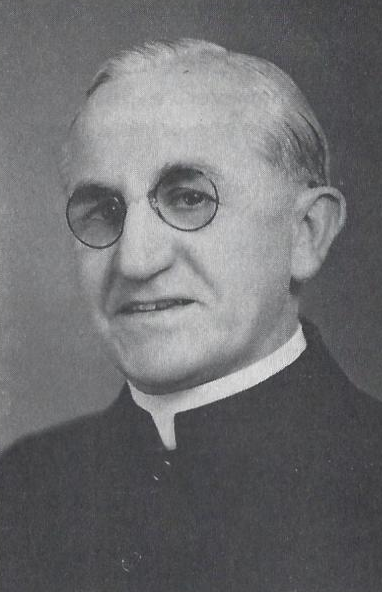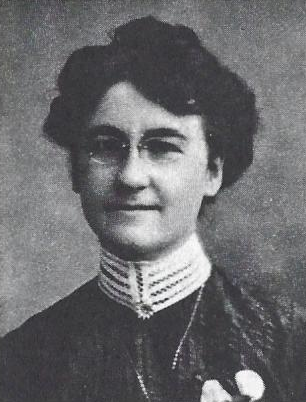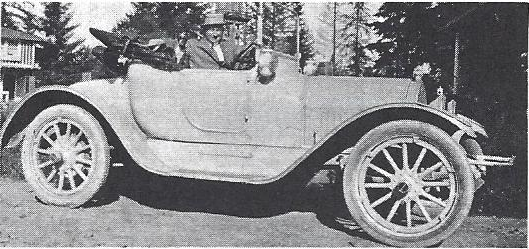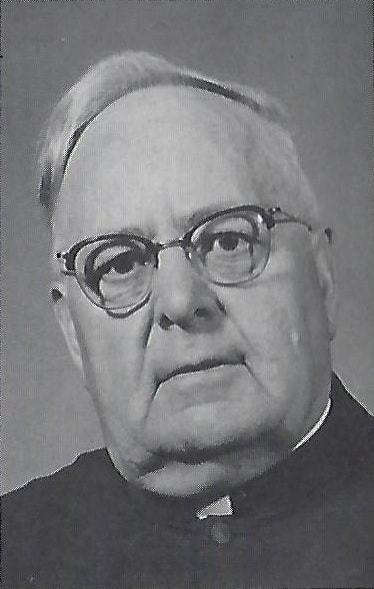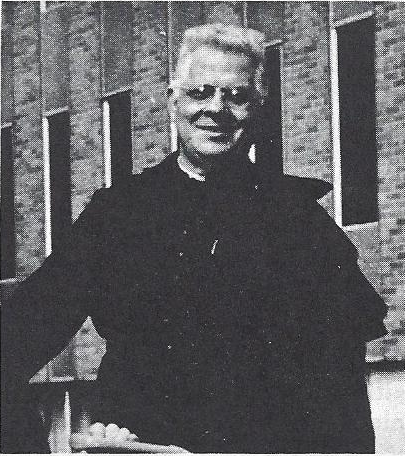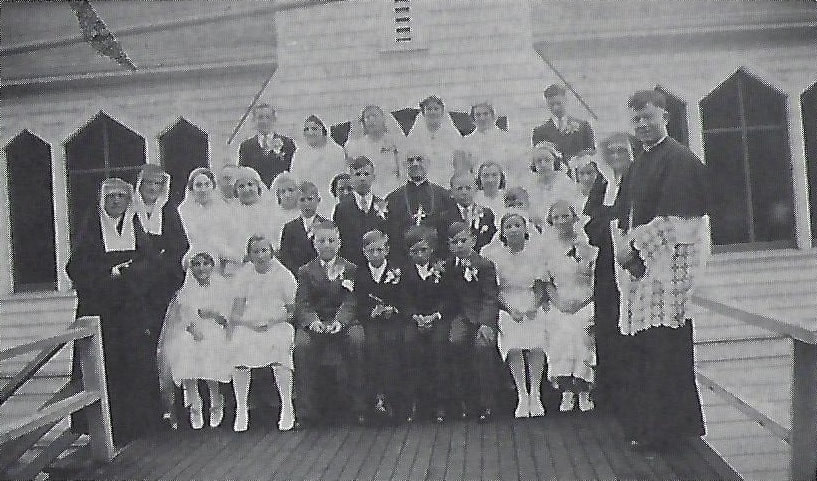Original church - 1916
The follow history was published in the 1976 souvenir program celebrating the Diamond Jubilee of the parish:
The History of St. Birgitta Parish
Part 1
In the first decade of this century there was no Catholic Church in Linnton nor were there many Catholic families; however, a priest came once a month from St. Patrick Church to say Mass in the private home of Anna Lembeck (now Mrs. Anna Engeldinger) who was born in Linnton in 1891 and now resides in Hillsboro, Oregon where she moved in 1914. The other Sundays people of Linnton went to Portland to hear Mass. When a few more families moved into the area, they rented a hall for Mass. (From a letter of Anna Engeldinger, October 12, 1966).
Father Charles M. Smith, Pastor of St. Clement's Church (now Assumption Church) in St. Johns, conducted two missions in Linnton during December 1915 and March 1916 in the Catholic Church Extension Society's “St. Peter's chapel car," which he also used in other parishes. The Chapel Car, a railroad car, was placed on side tracks at the Linnton depot. Missions were conducted in the evenings. Mr. George Hennessey, undertaker, who had a wonderful voice, used to come in the chapel car and sing during services. Some still remember how Father Smith baptized four girls in the chapel car, and how even friends of protestant faith came to these services. After these two missions, Most Reverend Archbishop Christie commissioned Father Smith to organize a mission parish at Linnton. (The town of Linnton "in 1915 was officially absorbed into the City of Portland," – See “The Oregonian", Portland, Oregon, April 30, 1961, p. 26).
Before the church of St. Birgitta was built, Mass was celebrated Sunday mornings in the town dance hall for a number of months. The first Mass was offered March 19, 1916. It was the first time many of the children had seen a priest or attended Mass. Seeing the priest at the altar, a boy began to cry, saying, "I do not like that man's dress". Mrs. J.J. Wilson, who after her husband's death married Mr. J. Reedy, had to start at about 7 AM, for 14 Sundays to put the dance hall in order for Mass. She carried in a suitcase the vestments, chalice, and altar stone, all of which weighed 14 lbs. It was about one mile each way to the church.
Due to the unusual geography of the place and location of the Catholics in that district, the little church was built about halfway between Linnton and Whitwood Court on two very steep lots donated by Mr. Walter Guerin. The building was built on stilts and had three stories. The top floor was the church which was connected by a wooden bridge to U. S. Highway 30. Under the church was the hall with the stairway leading to it, and the third floor was left open.
In order to place the other end of the bridge on the state highway property, Father Smith wrote asking permission. Since he did not receive any answer, he assumed that permission was not needed and proceeded to build the bridge. When all was finished, the state highway men came and demanded removal of the bridge which supposedly was built without their permission. When Father Smith produced the copy of his letter, which they had never answered, he was told that they respected his consideration in asking for permission and would allow him to use the bridge until the time came for them to make a change on the highway.
Msgr. Charles M. Smith, Founder
It was one of the most unusual church edifices not only in Oregon but in the United States. Father Smith often repeated that St. Birgitta's Church was three times in Ripley's "Believe It or Not."
After the church was built, General Petroleum Co. (now Mobil Co.) built its plant on three sides of the little church. The fourth side of it faced the highway.
The first Mass was celebrated in the new church on July 2, 1916. The dedication by Most Reverend Christie on July 16, 1916, was followed by the administration of Confirmation. After the ceremonies, Archbishop Christie and Father Smith were guests of Mr. & Mrs. J. J. Wilson for dinner.
The church cost about $2,000.00. The Catholic Church Extension Society of Chicago contributed $500.00 toward this amount and, since the donor of this money expressed the wish, the new church was dedicated to St. Birgitta. Some parishioners donated various articles for the church and the hall: statues, windows, tables, chairs, etc. With these donations as well as with financial offerings and many church activities such as dinners, sales, dances and others, the church was paid for within a short time.
There were about 100 people who attended this church. There was an altar society of about 44 members, seven or eight of whom were men. Mrs. J. J. Wilson taught catechism to about 40 children for 8 years. Serving faithfully as altar boy was Peter J. Ermler.
Father Charles Smith resided in St. Johns and every Sunday a young man, Mr. Edward Barry, used to row him across the Willamette River to the point where the present St. Johns Bridge is. From there Father Smith walked to the church and, after Mass, walked back to the same point. Mr. Barry who could see him walking from the other side of the river, would come and row him back. This was necessary because the ferry did not operate on Sundays.
According to an article in the Catholic Sentinel from October 5, 1916, Father Smith was transferred from St. Clements parish in St. Johns to the cathedral in 1916. On August 1, 1917, he was assigned to take care of the territory which is now St. Anthony's, Our Lady of Sorrows, and Holy Family parishes. He was succeeded at St. Birgitta’s by Redemptorist fathers from St. Clement's Parish in St. Johns. One of the priests was Father Nealon, C.Ss.R. He had charge of Linnton each Sunday. During his time at St. Birgitta's, the Christmas crib was provided through the generosity of Mr. and Mrs. J. J. Wilson.
Redemptorist fathers were in charge of St. Clement's and St. Birgitta's only for a short time. In 1917 the Servite fathers took over on request of Archbishop Christie. Father Vincent Healy O.S.M., and Father Lyons O.S.M., were in charge of St. Birgitta. The fathers used to come to Linnton on Saturday evening and stay overnight at Mr. J. J. Wilson's. They offered Mass at St. Birgitta's on Sunday at 8 o'clock in the morning, then left for North Plains by interurban car which came from Portland (later jitneys were introduced because interurban was losing money), where they offered the second Mass at 10 o'clock, and returned to Linnton by the same interurban by noon. After having dinner at Mr. J.J. Wilsons, they returned to St. John's. In the spirit of the first Christian families, who generously helped the Apostles and other missionaries in the vineyard of the Lord, the services at J.J. Wilson’s were always gratis to the priests.
After the church was built, General Petroleum Co. (now Mobil Co.) built its plant on three sides of the little church. The fourth side of it faced the highway.
The first Mass was celebrated in the new church on July 2, 1916. The dedication by Most Reverend Christie on July 16, 1916, was followed by the administration of Confirmation. After the ceremonies, Archbishop Christie and Father Smith were guests of Mr. & Mrs. J. J. Wilson for dinner.
The church cost about $2,000.00. The Catholic Church Extension Society of Chicago contributed $500.00 toward this amount and, since the donor of this money expressed the wish, the new church was dedicated to St. Birgitta. Some parishioners donated various articles for the church and the hall: statues, windows, tables, chairs, etc. With these donations as well as with financial offerings and many church activities such as dinners, sales, dances and others, the church was paid for within a short time.
There were about 100 people who attended this church. There was an altar society of about 44 members, seven or eight of whom were men. Mrs. J. J. Wilson taught catechism to about 40 children for 8 years. Serving faithfully as altar boy was Peter J. Ermler.
Father Charles Smith resided in St. Johns and every Sunday a young man, Mr. Edward Barry, used to row him across the Willamette River to the point where the present St. Johns Bridge is. From there Father Smith walked to the church and, after Mass, walked back to the same point. Mr. Barry who could see him walking from the other side of the river, would come and row him back. This was necessary because the ferry did not operate on Sundays.
According to an article in the Catholic Sentinel from October 5, 1916, Father Smith was transferred from St. Clements parish in St. Johns to the cathedral in 1916. On August 1, 1917, he was assigned to take care of the territory which is now St. Anthony's, Our Lady of Sorrows, and Holy Family parishes. He was succeeded at St. Birgitta’s by Redemptorist fathers from St. Clement's Parish in St. Johns. One of the priests was Father Nealon, C.Ss.R. He had charge of Linnton each Sunday. During his time at St. Birgitta's, the Christmas crib was provided through the generosity of Mr. and Mrs. J. J. Wilson.
Redemptorist fathers were in charge of St. Clement's and St. Birgitta's only for a short time. In 1917 the Servite fathers took over on request of Archbishop Christie. Father Vincent Healy O.S.M., and Father Lyons O.S.M., were in charge of St. Birgitta. The fathers used to come to Linnton on Saturday evening and stay overnight at Mr. J. J. Wilson's. They offered Mass at St. Birgitta's on Sunday at 8 o'clock in the morning, then left for North Plains by interurban car which came from Portland (later jitneys were introduced because interurban was losing money), where they offered the second Mass at 10 o'clock, and returned to Linnton by the same interurban by noon. After having dinner at Mr. J.J. Wilsons, they returned to St. John's. In the spirit of the first Christian families, who generously helped the Apostles and other missionaries in the vineyard of the Lord, the services at J.J. Wilson’s were always gratis to the priests.
Fr. Vincent Healy, O.S.M.
Mrs. J.J. Wilson (later Mrs. J. Reedy)
Mr. William O'Brien
At that time there was another Catholic family who deserves much credit for their work for St. Birgitta’s. Mr. William O'Brien, who lived in the Willbridge district, which belonged to St. Birgitta's Parish, with his son, Alfred, and three daughters, Mabel (Mrs. Herbert F. Thomas of Portland), Frances, (Mrs. George Hill of Tacoma), and Vera (Mrs. Paul Miller of Portland). Mr. O'Brien had the railway equipment shop in Willbridge. He and his three daughters with Irene Bodway as organist, and her mother, Mrs. Bodway, comprised the church choir. Mr. O'Brien installed the gas heating in the church and the hall, as well as a gas range in the hall kitchen. Since St. Birgitta Church and hall were built on stilts, Mr. O'Brien had the basement enclosed making a fine third story under the church hall. This was accomplished during the pastorate of Fr. V. Healy, O.S.M., at the request of the City of Portland, a septic tank had to be installed since there was no sewer system in Linnton. Mr. O'Brien paid for all this, too.
Fr. V. Healy, O.S.M., left St. Birgitta in the Fall of 1918, and Father Hyacinth Wiecorik, O.S.M., replaced him. He obtained a car through the help of parishioners, especially of Mr. W. O'Brien, who contributed a substantial sum for it.
On June 1, 1918, Father Charles M. Smith was appointed pastor of St. Patrick and, not long after, St. Birgitta was served by the priests from St. Patrick. Father (now Msgr.) Theodore Bernards, being assistant to Father Smith, worked also at St. Birgitta's. He was responsible for transporting the children by bus from Linnton to St. Patrick' s school.
Fr. V. Healy, O.S.M., left St. Birgitta in the Fall of 1918, and Father Hyacinth Wiecorik, O.S.M., replaced him. He obtained a car through the help of parishioners, especially of Mr. W. O'Brien, who contributed a substantial sum for it.
On June 1, 1918, Father Charles M. Smith was appointed pastor of St. Patrick and, not long after, St. Birgitta was served by the priests from St. Patrick. Father (now Msgr.) Theodore Bernards, being assistant to Father Smith, worked also at St. Birgitta's. He was responsible for transporting the children by bus from Linnton to St. Patrick' s school.
Fr. Theo. J. Bernards
On June 24, 1927, Father Smith left St. Patrick's and became pastor at St. Anthony's for the second time. However, for a while, after leaving St. Patrick's, he went to St. Birgitta’s and lived in the church hall. Mr. John Kovach still remembers how Father Smith had a couch in the hall, which he used for his bed, too. He would go on mission trips and come back to St. Birgitta. No doubt, his mission trips were made to St. Anthony's.
When Father Smith moved out, a priest from the Midwest, Father Burkel, was sent to St. Birgitta by Father Black, who was in charge of the Archdiocese while Archbishop Christie was ill. He remained at St. Birgitta for about two years. He had his own car and served St. Birgitta and North Plains. He converted the hall under the church into living quarters spending about $2.000.00. Since he had Mass at St. Birgitta's at 8 o'clock in the morning, and then went to North Plains for the second Mass at 10 or 11AM, many people of St. Birgitta, not being willing to get up so early on Sundays, went to Mass at St. Patrick or the Cathedral in their own cars or to St. Stanislaus by street car which traveled from the city center via Mississippi Ave. To make it possible for Father Burkel to live at St. Birgitta, the people pledged $5.00 a month for his support, but many moved and confusion took place, as is often the case when there is a question of money.
When Father Smith moved out, a priest from the Midwest, Father Burkel, was sent to St. Birgitta by Father Black, who was in charge of the Archdiocese while Archbishop Christie was ill. He remained at St. Birgitta for about two years. He had his own car and served St. Birgitta and North Plains. He converted the hall under the church into living quarters spending about $2.000.00. Since he had Mass at St. Birgitta's at 8 o'clock in the morning, and then went to North Plains for the second Mass at 10 or 11AM, many people of St. Birgitta, not being willing to get up so early on Sundays, went to Mass at St. Patrick or the Cathedral in their own cars or to St. Stanislaus by street car which traveled from the city center via Mississippi Ave. To make it possible for Father Burkel to live at St. Birgitta, the people pledged $5.00 a month for his support, but many moved and confusion took place, as is often the case when there is a question of money.
Fr. George Dum, C.S.C.
For a while St. Birgitta Parish was served by Father William Hampson, pastor of St. Cecilia (now Queen of Peace). He had one Mass at St. Cecilia and a second Mass at St. Birgitta. Mr. William Theis, a parishioner of St. Birgitta, used to transport him in his car by way of the ferry across the river before the St. Johns Bridge was opened in 1933. After Father Hampson, St. Birgitta was served by the Holy Cross fathers from the University of Portland sometime before 1930. Mr. Theis remembers bringing them in his car on the ferry before the bridge was opened. Father Michael Muicaire, C.S.C., Father Robert Sweeney, C.S.C., Father James Fogarty, C.S.C., Father John Hooyboer, C.S.C., and Father George Dum, C.S.C., used to work at St. Birgitta's prior to 1938. Mrs. Dorothy Hanson still remembers how people used to walk to church on Sundays and for Lenten devotions. The church, being small, always looked full.
At St. Birgitta's the pastors had taken care of finances. However, in the late Twenties, when a trustee system was formed, a board of directors was elected by the people. There were five members: Mr. William Theis, secretary-treasurer; Mr. John Dodak; Mr. J. Kovach; Mr. Herman Bishel; and Mrs. Andy Ballas. During the term of Mr. Theis, the exterior of the church was painted, partly with free labor and partly paid for.
In 1934, when Mr. Theis quit the office, Mr. John Kovach took charge of financial affairs of the parish with the help of Mr. Edward Kost as secretary. During 1936 and 1937 a new addition to the original church was built enlarging the capacity of the church and changing the shape. The extended church was officially dedicated in November of 1937, as Mr. John Kovach remembers.
At St. Birgitta's the pastors had taken care of finances. However, in the late Twenties, when a trustee system was formed, a board of directors was elected by the people. There were five members: Mr. William Theis, secretary-treasurer; Mr. John Dodak; Mr. J. Kovach; Mr. Herman Bishel; and Mrs. Andy Ballas. During the term of Mr. Theis, the exterior of the church was painted, partly with free labor and partly paid for.
In 1934, when Mr. Theis quit the office, Mr. John Kovach took charge of financial affairs of the parish with the help of Mr. Edward Kost as secretary. During 1936 and 1937 a new addition to the original church was built enlarging the capacity of the church and changing the shape. The extended church was officially dedicated in November of 1937, as Mr. John Kovach remembers.
Extended Church – 1936-1937
The cost of the addition to the original building was about $10,000.00. To provide money, Mr. John Kovach, Mr. John Dodak, and Mr. Andy Ballas collected money from parishioners of Slovak.descent, while Mr. Edward Kost and Father M. Mulcare went to see other Catholic families.
Mr. John Kovach, with the approval of Archbishop Howard, was conducting the building project, paying all the bills, as the financial records still kept by him prove.
At the time Mr. Kovach took over, the financial condition was poor. The parish still owed to the fathers of the University of Portland the sum of $700.00 for previous service. In order to help the situation, Mr. J. Kovach was instrumental in changing the meeting place of the members of the Slovak Catholic lodge from St. Patrick's Hall to St. Birgitta. To make it more solemn, the lodge invited Father Zalud, of Czech descent, pastor in Scappoose, to bless the banners of the Slovak lodge. Since he was about 70 years old and thought that St. Wenceslaus Parish in Scappoose was too big for him, he indeed wanted to take over St. Birgitta. Meanwhile, he died, and he never became pastor of St. Birgitta.
Members of the Slovak lodge organized dances in Scappoose and used the proceeds to help St. Birgitta, St. Patrick, and the lodge itself. While Mr. John Kovach was in charge of finances between the years 1934 and 1950, he paid all the bills and left $2,000.00 in the bank.
Mr. John Kovach, with the approval of Archbishop Howard, was conducting the building project, paying all the bills, as the financial records still kept by him prove.
At the time Mr. Kovach took over, the financial condition was poor. The parish still owed to the fathers of the University of Portland the sum of $700.00 for previous service. In order to help the situation, Mr. J. Kovach was instrumental in changing the meeting place of the members of the Slovak Catholic lodge from St. Patrick's Hall to St. Birgitta. To make it more solemn, the lodge invited Father Zalud, of Czech descent, pastor in Scappoose, to bless the banners of the Slovak lodge. Since he was about 70 years old and thought that St. Wenceslaus Parish in Scappoose was too big for him, he indeed wanted to take over St. Birgitta. Meanwhile, he died, and he never became pastor of St. Birgitta.
Members of the Slovak lodge organized dances in Scappoose and used the proceeds to help St. Birgitta, St. Patrick, and the lodge itself. While Mr. John Kovach was in charge of finances between the years 1934 and 1950, he paid all the bills and left $2,000.00 in the bank.
1st Communion Class, 1937
Confirmation Class, 1937
Sometime after Father Zalud died, Father Hotovy, of Czech descent, came from Nebraska as pastor in Scappoose. Through the efforts of Mr. John Kovach, it was arranged with the father from the University of Portland and approved by the Most Reverend Archbishop Edward D. Howard that one Sunday a month Father Hotovy would come to St. Birgitta to say Mass and preach and hear confessions in Slovak, and the father from the University of Portland would go to Scappoose. Due to the fact that Father Hotovy served Slovak people in the Slovak language, Slovaks from other parishes in the City of Portland would come to St. Birgitta on that Sunday. Mr. John Kovach, worrying about the bills, did not mind seeing the Slovaks come, because on that Sunday the collection would come up to $13.00, while on other Sundays the collection was only about $2.00, often even less.
© Copyright 2024 St. Birgitta Catholic Church. All rights reserved.

